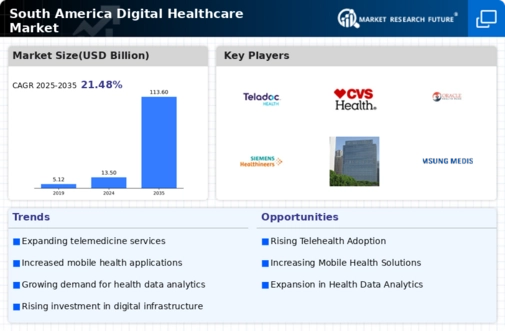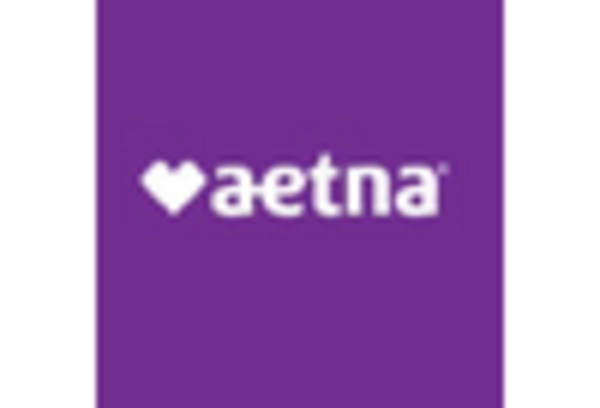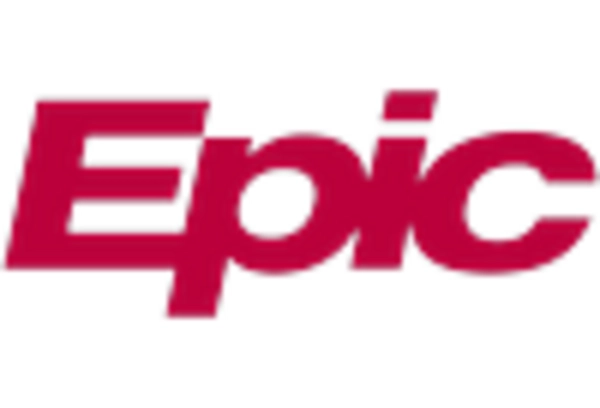Increased Health Awareness
There is a notable rise in health awareness among the South American population, which is driving the digital healthcare market. As individuals become more informed about health issues and preventive care, they are increasingly seeking digital solutions to manage their health. Surveys indicate that around 70% of the population is now using health-related apps or online resources to track their wellness. This trend is likely to encourage healthcare providers to develop user-friendly digital platforms that cater to the growing demand for health information and services. Moreover, the emphasis on preventive care and wellness management is expected to propel the market forward, with an anticipated growth rate of 10% annually. As a result, the digital healthcare market is becoming more competitive, with various players striving to meet the evolving needs of health-conscious consumers.
Rising Internet Penetration
The increasing availability of internet access across South America is a crucial driver for the digital healthcare market. As of 2025, internet penetration in the region has reached approximately 75%, facilitating the adoption of various digital health solutions. This connectivity enables healthcare providers to offer telemedicine services, access electronic health records, and utilize mobile health applications. The digital healthcare market is likely to benefit from this trend, as more individuals gain access to online health resources. Furthermore, the growth of mobile internet usage, which stands at around 60%, suggests that patients are more inclined to engage with healthcare services through their smartphones. This shift not only enhances patient engagement but also encourages healthcare providers to invest in digital solutions, thereby expanding the market's reach and potential.
Government Initiatives and Support
Government initiatives aimed at promoting digital health solutions are significantly influencing the digital healthcare market in South America. Various countries in the region have implemented policies to enhance healthcare access through technology. For instance, Brazil's Ministry of Health has launched programs to integrate telemedicine into public health services, aiming to improve healthcare delivery in remote areas. Such initiatives are expected to increase the market size, with projections indicating a growth rate of around 15% annually. Additionally, funding opportunities and grants for digital health startups are becoming more prevalent, further stimulating innovation and development within the sector. This supportive environment encourages collaboration between public and private entities, fostering a robust ecosystem for digital healthcare solutions.
Aging Population and Chronic Diseases
The demographic shift towards an aging population in South America is a significant driver for the digital healthcare market. By 2025, it is estimated that over 20% of the population will be aged 60 and above, leading to a higher prevalence of chronic diseases such as diabetes and hypertension. This demographic trend necessitates the adoption of digital health solutions to manage these conditions effectively. Telehealth services and remote monitoring tools are increasingly being utilized to provide continuous care and support for elderly patients. The market is projected to grow by approximately 12% annually, driven by the demand for innovative healthcare solutions that cater to the needs of this demographic. Consequently, healthcare providers are likely to invest in digital technologies to enhance patient outcomes and streamline care delivery.
Technological Advancements in Healthcare
Technological advancements are playing a pivotal role in shaping the digital healthcare market in South America. Innovations such as artificial intelligence, machine learning, and blockchain technology are being integrated into healthcare systems, enhancing efficiency and security. For instance, AI-driven diagnostic tools are improving the accuracy of disease detection, while blockchain is ensuring secure patient data management. The market is projected to expand by approximately 18% annually, driven by these technological innovations. Furthermore, the increasing adoption of wearable devices is enabling real-time health monitoring, which is becoming increasingly popular among consumers. This trend not only empowers patients to take charge of their health but also provides healthcare providers with valuable data to improve care delivery. As technology continues to evolve, the digital healthcare market is likely to witness further growth and transformation.


















Leave a Comment